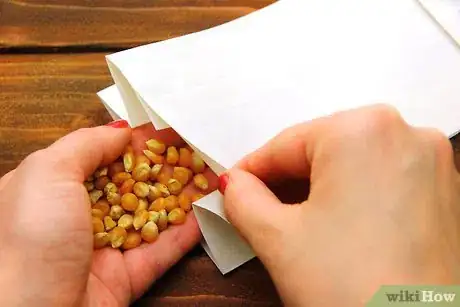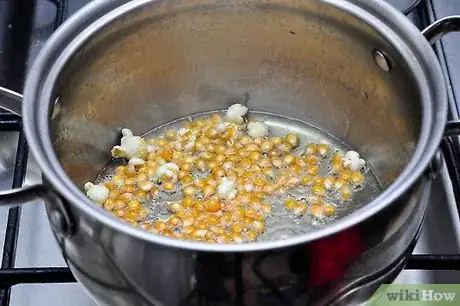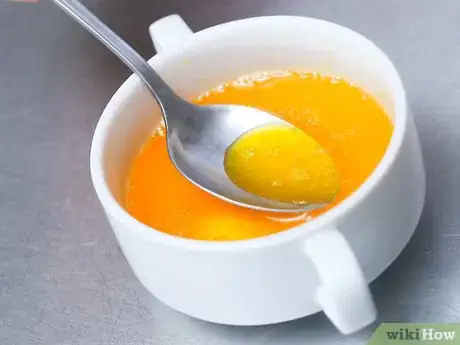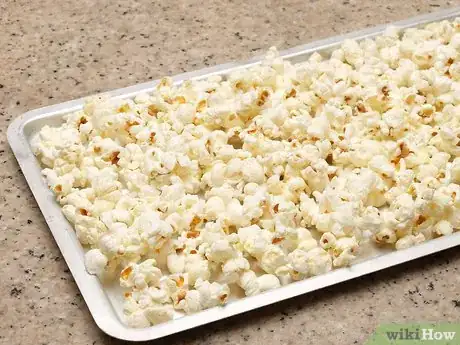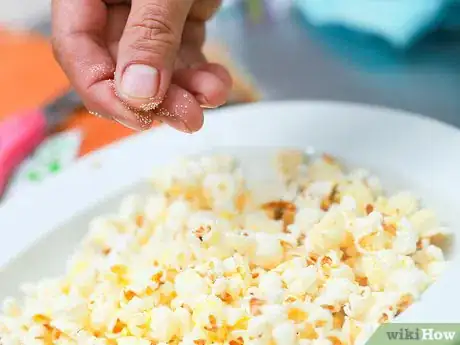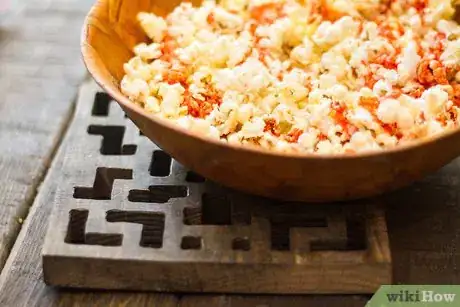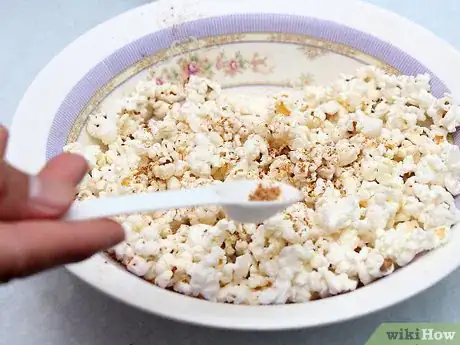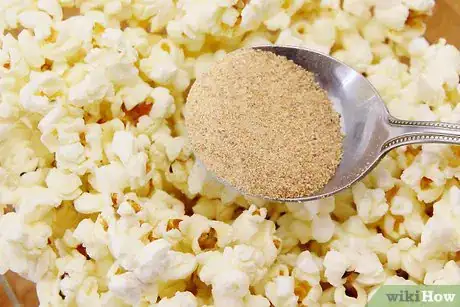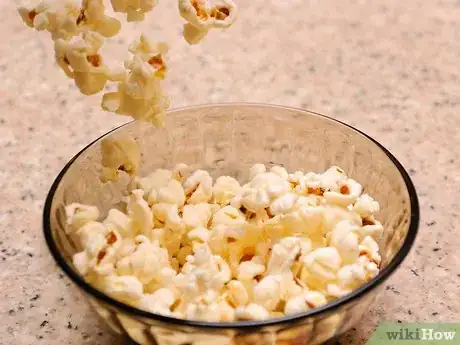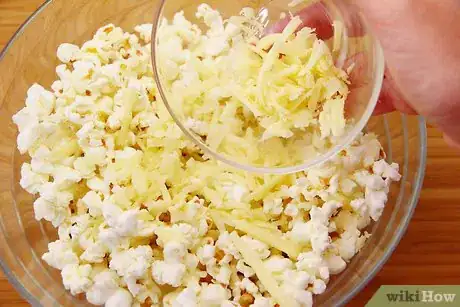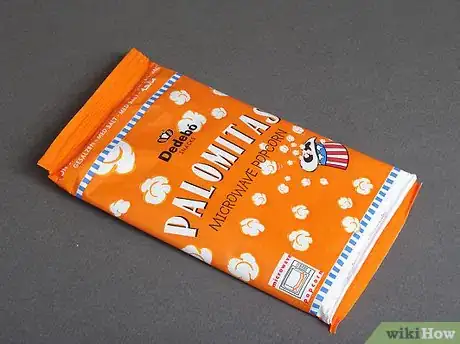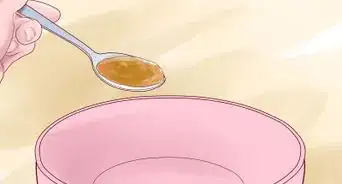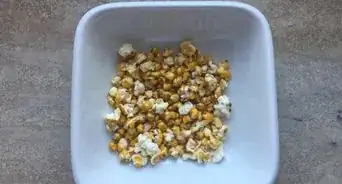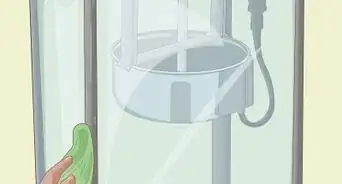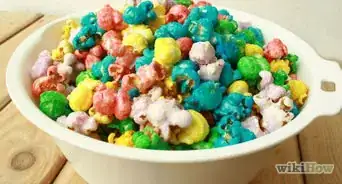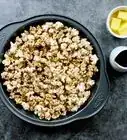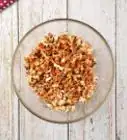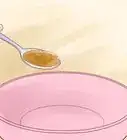This article was co-authored by John Burson. John Burson is a Certified Nutritionist, Licensed Herbalist, and Certified Personal Trainer. With over 25 years of experience, John specializes in helping clients lose weight and live healthier lives. John graduated magna cum laude and received a Bachelor’s degree in Business and Marketing from Grand Canyon University. He has also earned Thumbtack Top Pro honos for three consecutive years.
This article has been viewed 9,996 times.
Popcorn can be a tasty and easy snack to prepare. It can also be pretty healthy because it contains less than 50 calories per serving and is a great source of fiber. Unfortunately, the way that you prepare it and the toppings that you add can load it up with calories and fat to take it from healthy to frightening in a hurry. Making the simple change to air popping or using a healthy oil to pop your popcorn can help keep your favorite snack healthy. It's also important to cut down on the butter that you top it with, and look for alternative seasonings to keep the flavor in your popcorn high while still keeping the fat, calories, and sodium low.
Steps
Choosing the Right Popping Method
-
1Use an air popper. The healthiest way to make popcorn is with an air popper. It is an appliance that just uses hot air to heat the kernels and pop them, so you don’t need to use any butter or oil. That means your popcorn has fewer calories and less fat than microwave popcorn or popcorn that’s popped in oil or butter in a skillet.[1]
- Air poppers are relatively inexpensive, usually ranging in price for $15 to $35. If you eat a lot of popcorn, purchasing one may be a good investment.
- Using an air popper is easy, but always consult the instruction manual. In most cases, you only need to pour some corn kernels in the popping chamber, place a bowl under the popper’s chute, and turn it on. The popper usually takes several minutes to finish popping a batch of popcorn.
-
2Air pop your popcorn in the microwave. If you don’t want to invest in an air popper, you can air pop your popcorn in your microwave. Put approximately 3 tablespoons (36 g) of corn kernels into a brown paper bag and fold the bag closed. Microwave the bag on high for approximately 1 minute and 30 seconds or until all of the kernels are popped.[2]
- Exact cooking times will vary based on your microwave. Start with a minute and half, and only heat it longer if there are a bunch of unpopped kernels left.
- You can tape the bag shut if you’re concerned about the popcorn escaping from the bag as it pops.
Advertisement -
3Make popcorn on the stovetop with healthy oils. While air-popped popcorn is usually the healthiest way to enjoy popcorn, you may want to cook it in oil on the stovetop for added flavor. However, it’s important to choose a healthy oil so use one that is low in saturated fat.[3]
- Extra virgin olive, walnut, and avocado oils are usually the best options for popping popcorn.
- Canola oil is a decent option, but it has more saturated fat.
- Avoid popping your popcorn in soybean, sunflower, or corn oil.
- You can also prepare stovetop popcorn with water instead of oil.[4]
- To make popcorn on the stove, heat 3 tablespoons (45 ml) of your chosen oil in a saucepan with a thick bottom on medium high. Add ⅓ cup (75 g) of popcorn kernels to the pan in a single layer. Cover the pan, and remove it from the heat for 30 seconds. Return the pan to the heat, and the popcorn will start popping. Take the pan off the heat when there’s more than 2 to 3 seconds between pops.
Making Skinny Buttered Popcorn
-
1Combine melted butter and water in a spray bottle. Add 1 teaspoon (5 g) melted unsalted butter and ¼ teaspoon (1 ml) of hot water to a clean spray bottle. Shake the bottle vigorously to mix the two together.[5]
- The water doesn’t need to be boiling. Hot water from the tap is warm enough.
- Don’t substitute margarine for the butter. It had a tendency to clump up so it won’t spray well.
-
2Spread out air-popped popcorn on a cookie sheet. Take 8 cups (64 g) of plain, air-popped popcorn, and place it on a cookie sheet. Be sure to lay the popcorn out in a single layer.[6]
- You can also spread the popcorn out on a large piece of foil.
-
3Spray the popcorn with the butter mixture. Once the popcorn is spread out, lightly spray it with the butter and water mixture. Be sure to spray evenly so the butter flavor is evenly distributed. Transfer the popcorn to a bowl, and serve.[7]
- You can sprinkle some salt over the popcorn after you spray it. However, don’t use too much or the popcorn will have too much sodium.
- You can also sprinkle the popcorn with a lighter seasoning after spraying it for extra flavor.
Using Lighter Seasonings on Your Popcorn
-
1Sprinkle with cayenne pepper or chili powder. If you want to give your plain popcorn a spicy kick, dust it with a little cayenne pepper or chili powder. You can add as much or as little as you like, depending on how much heat you want your popcorn to have. Toss the popcorn well to ensure that the seasoning is evenly distributed.[8]
- You can also season your popcorn with taco seasoning, but choose a salt-free or low-salt option to keep your popcorn on the healthy side.
- Tossing your popcorn with some hot sauce can also give it some tasty heat. Just be careful not to add too much or the popcorn may get soggy.
-
2Season with Old Bay or jerk seasoning. If you want your plain popcorn to have more distinct spicy flavor, sprinkle some Old Bay or jerk seasoning over it. Look for a salt-free option, though, to make sure that the popcorn doesn’t have too much sodium.[9]
- Make sure to toss the popcorn well after you add the Old Bay or jerk seasoning to make sure that the seasoning doesn’t clump together.
-
3Add garlic powder and parmesan cheese. Garlic and parmesan cheese make an ideal topping for plain popcorn. Sprinkle a little of each over your popcorn, and toss well to coat. Be careful not to use too much cheese, though -- it can be high in sodium.[10]
- If you’re having trouble getting the garlic powder and cheese to stick to all of the popcorn, mist it lightly with olive oil first to give it something to stick to.
Monitoring Your Popcorn Consumption
-
1Learn the proper serving size. Serving sizes will vary based on the type of popcorn that you’re eating, but 1 cup of plain, popped popcorn contains 30 calories. Make sure to measure how much you’re adding to the bowl that you plan to eat from so you know the precise amount that you’re eating.[11]
- Keep in mind that any toppings that you add to your popcorn, such as butter, oil, or parmesan cheese, will add extra calories and fat. Measure the toppings too, so you can keep track of how much you’re eating.
-
2Eat your popcorn with protein. You can make your popcorn more filling by pairing it with protein. Proteins are usually more filling than the carbohydrates in the popcorn, so you feel full longer if you eat your popcorn with a tablespoon (16 g) of peanut butter or 2 ounces (75 g) of cheese. That can help keep you from overeating.[12]
- You can eat the popcorn with your favorite protein. Just be aware of the serving size for the food, so you don’t overeat.
- If you’ve already topped your popcorn with parmesan cheese, it’s best not to eat it with cheese. You may wind up consuming too much fat and sodium.
-
3Avoid microwave popcorn. While making microwave popcorn may be quick and easy, it is often extremely unhealthy because it’s full of sodium and artificial flavorings. It’s also hard to control the portions that you eat because the bags are large. Make your own popcorn so you can control how much eat and what goes into it.[13]
- Don’t assume that light or low-fat microwave popcorn is healthy. It is usually loaded with sodium and artificial butter flavoring that can be very unhealthy.
Expert Q&A
-
QuestionIs popcorn healthy?
 John BursonJohn Burson is a Certified Nutritionist, Licensed Herbalist, and Certified Personal Trainer. With over 25 years of experience, John specializes in helping clients lose weight and live healthier lives. John graduated magna cum laude and received a Bachelor’s degree in Business and Marketing from Grand Canyon University. He has also earned Thumbtack Top Pro honos for three consecutive years.
John BursonJohn Burson is a Certified Nutritionist, Licensed Herbalist, and Certified Personal Trainer. With over 25 years of experience, John specializes in helping clients lose weight and live healthier lives. John graduated magna cum laude and received a Bachelor’s degree in Business and Marketing from Grand Canyon University. He has also earned Thumbtack Top Pro honos for three consecutive years.
Certified Nutritionist By itself, popcorn is a very healthy snack. In fact, there's evidence that popcorn can lower the risk of heart disease and diabetes.
By itself, popcorn is a very healthy snack. In fact, there's evidence that popcorn can lower the risk of heart disease and diabetes. -
QuestionWhat can I put on popcorn to make it better?
 John BursonJohn Burson is a Certified Nutritionist, Licensed Herbalist, and Certified Personal Trainer. With over 25 years of experience, John specializes in helping clients lose weight and live healthier lives. John graduated magna cum laude and received a Bachelor’s degree in Business and Marketing from Grand Canyon University. He has also earned Thumbtack Top Pro honos for three consecutive years.
John BursonJohn Burson is a Certified Nutritionist, Licensed Herbalist, and Certified Personal Trainer. With over 25 years of experience, John specializes in helping clients lose weight and live healthier lives. John graduated magna cum laude and received a Bachelor’s degree in Business and Marketing from Grand Canyon University. He has also earned Thumbtack Top Pro honos for three consecutive years.
Certified Nutritionist Avoid butter, sweeteners, and oils for seasoning. Instead, use herbal condiments, balsamic vinegar, pickles, or peppers.
Avoid butter, sweeteners, and oils for seasoning. Instead, use herbal condiments, balsamic vinegar, pickles, or peppers.
References
- ↑ https://health.clevelandclinic.org/2016/03/9-best-tips-help-make-healthier-popcorn/
- ↑ http://chaosinthekitchen.com/2009/06/homemade-air-popped-microwaveable-popcorn/
- ↑ https://health.clevelandclinic.org/2016/03/9-best-tips-help-make-healthier-popcorn/
- ↑ John Burson. Certified Nutritionist. Expert Interview. 9 June 2021.
- ↑ http://amyshealthybaking.com/blog/2014/08/14/skinny-buttered-popcorn/
- ↑ http://amyshealthybaking.com/blog/2014/08/14/skinny-buttered-popcorn/
- ↑ http://amyshealthybaking.com/blog/2014/08/14/skinny-buttered-popcorn/
- ↑ http://www.sparkpeople.com/blog/blog.asp?post=23_ways_to_top_your_popcorn_for_under_150_calories
- ↑ http://www.sparkpeople.com/blog/blog.asp?post=23_ways_to_top_your_popcorn_for_under_150_calories
- ↑ http://www.sparkpeople.com/blog/blog.asp?post=23_ways_to_top_your_popcorn_for_under_150_calories
- ↑ https://health.clevelandclinic.org/2016/03/9-best-tips-help-make-healthier-popcorn/
- ↑ https://health.clevelandclinic.org/2016/03/9-best-tips-help-make-healthier-popcorn/
- ↑ https://health.clevelandclinic.org/2016/03/9-best-tips-help-make-healthier-popcorn/
